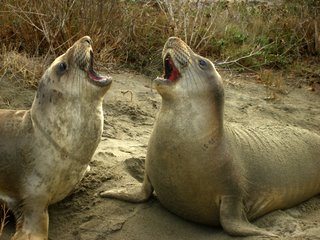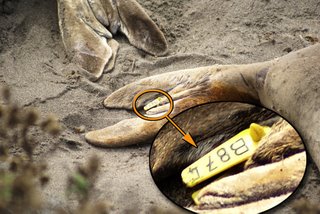
A male elephant seal.
Towards the end of November the first males begin to arrive and sort out the hierarchy of dominant bulls, the ones best positioned to mate with most females. Timing is critical. The dominant bulls will be spending 3 moths on the beach, fasting the entire time, fending off the approaches of subdominant bulls. and mating with as many females as possible. The large bulls will lose 8 -12 pounds a day. If they arrive on the each too soon, they use up valuable energy; if they arrive too late, they may miss out on the best positions. Only 5-10% of the males live to prime breeding age, and not all of those get a chance to breed.

When elephant seals are on land, they are here for a purpose: giving birth, breeding or molting. Because they are fasting it is important that they concerve energy and not move about any more than necessary. If you are patient, you may observe them in activities like practice sparring during the molting haul-out, or during breeding season you man observe them fighting, mating attempts, or birth They will move when it is necessary.

Elephant Seal pups.
Only about half of the weaned pups who leave the rockery will live to return. Fewer than 20% live beyond age 3. Studies show that a larger pup doesn't nessarily have an advantage interms of survival. Apparently, the juvenile death rate at sea is related to the ability to find food and avoid predators.

*You've got bad breathe. =P

We noticed this tag and took a picture of it and reported it to one of the docents that was on location.
Researchers use color code tags, attached to the rear flippers, to identify individuals. A few of the commonly sighted tags and location of tags are:
Red - San Nicolas Island
Yellow - San Miguel Island
Green - Ano Nuevo
Pink - Farallon Islands/Pt. Reyes
White - Piedras Blancas
Orange - Rehabilitation
Purple - Cape San Martin/Gorda
If you see this tag please report it to one of the docents so the information may be passed along to the appropriate research agancy. Between 5% to 10% of the seals are tagged.
2 comments:
That is fascinating information about the elephant seals. I'm very familiar with the Channel Islands because I grew up near there! Amazing how far some of those seals travel to breed/nest/molt.
Wow, if I was able to lose 8-12 lbs a day, I'd be at my goal weight in less than a week!
Neat post, I am inspired to track down some elephant seals this winter.
Post a Comment